Instructor Planning Guide
Activities
What activities are associated with this chapter?
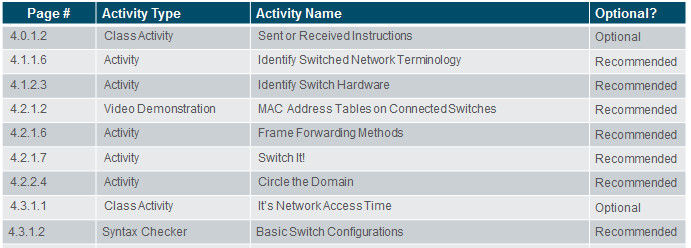
Assessment
Students should complete Chapter 4, “Assessment” after completing Chapter 4.
Quizzes, labs, Packet Tracers and other activities can be used to informally assess student progress.
Sections & Objectives
4.1 LAN Design
Explain how switched networks support small to medium-sized businesses.
Explain how data, voice, and video are converged in a switched network.
Describe a switched network in a small to medium-sized business.
4.2 The Switched Environment
Explain how Layer 2 switches forward data in a small to medium-sized LAN.
Explain how frames are forwarded in a switched network.
Compare a collision domain to a broadcast domain.
Chapter 4: Switched Networks
4.1 – LAN Design
4.1.1 – Converged Networks
4.1.1.1 – Growing Complexity of Networks
Next-generation networks need to be secure, reliable, and highly available.
They must support a globalized workforce.
They must be able to integrate legacy devices.

4.1.1.2 – Elements of a Converged Network
Converged network solutions integrate voice systems, IP phones, voice gateways, video support, and video conferencing.
Primary benefit of the converged network – just one physical network to install and manage.
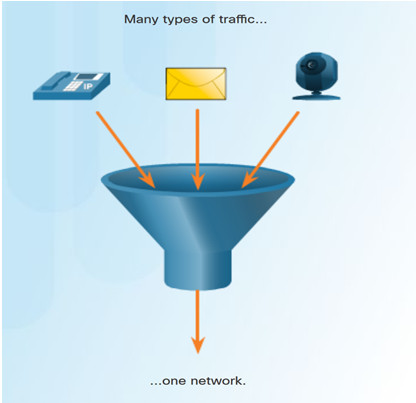
4.1.1.3 – Cisco Borderless Networks
The Cisco Borderless Network has the following features:
- Allows organizations to connect anyone, anywhere, anytime, on any device; securely, reliably, and seamlessly.
- Provides the framework to unify wired and wireless access, including policy, access control, and performance management across many different device types.
- Provides network services, and user and endpoint services that are all managed by an integrated management solution.
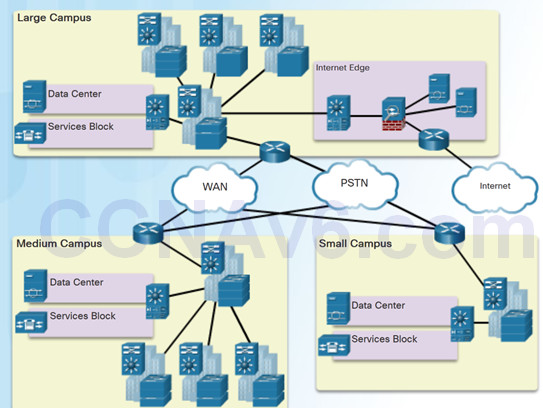
4.1.1.4 – Hierarchy in the Borderless Switched Network
Borderless switched network design guidelines are based on the following principles:
- Hierarchical – Facilitates understanding the role of each device at every tier.
- Modularity – Allows seamless network expansion and integrated services.
- Resiliency – Provides an always available network.
- Flexibility – Allows intelligent traffic load sharing.
The three tiers of the hierarchical model are Access, Distribution and Core layers.
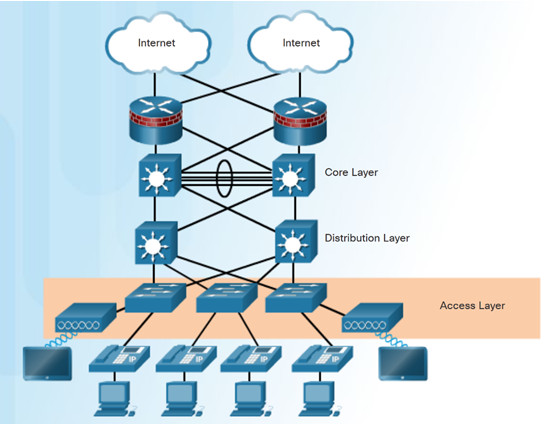
4.1.1.5 – Access, Distribution, and Core Layers
Access Layer – provides network access to the user.
Distribution Layer – interfaces between the access layer and the core layer. Provides functions such as:
- aggregating Layer 2 broadcast domains and Layer 3 routing boundaries.
- providing intelligent switching, routing, and network access policy functions to access the rest of the network.
Core Layer – is the network backbone. It provides fault isolation and high-speed backbone connectivity.

Smaller networks that do not need a separate distribution and core layer often use a two-tier campus or collapsed core network design.
4.1.2 – Switched Networks
4.1.2.1 – Role of Switched Networks
A hierarchical switched LAN allows more flexibility, traffic management, and additional features:
- Quality of service
- Additional security
- Support for wireless networking and connectivity
- Support for new technologies.
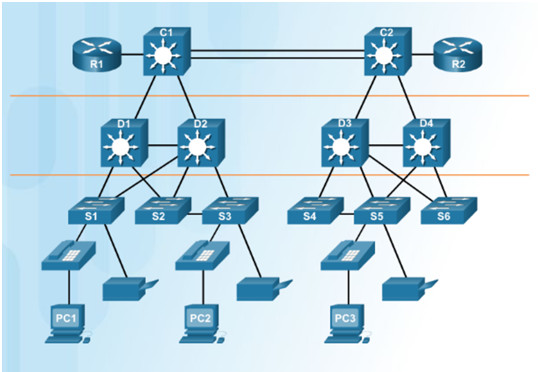
4.1.2.2 – Form Factors
Considerations when selecting switches:
- Cost
- Port Density
- Power
- Reliability
- Port Speed
- Frame buffers
- Scalability
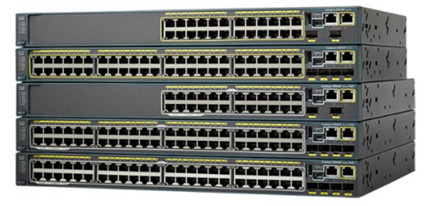
Fixed Configuration
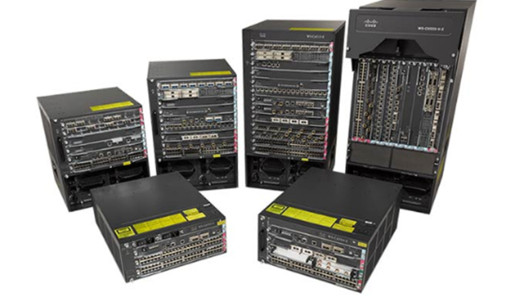
Modular Configuration
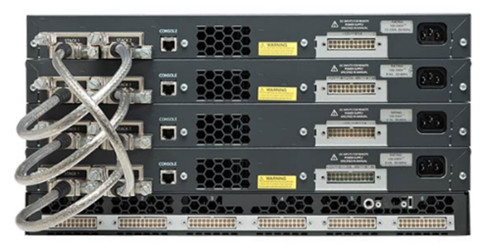
Stackable Configuration
4.2 – The Switched Environment
4.2.1 – Frame Forwarding
4.2.1.1 – Switching as a General Concept in Networking and Telecommunications
A LAN switch makes decisions based on two criteria:
- Ingress port – where a frame enters the device
- Destination address
A LAN switch maintains a table that it uses to determine how to forward traffic.
In the diagram, If a message enters switch port 1 with a destination address of EA, then the switch forwards the traffic out port 4.
Layer 2 Ethernet switches forward frames based on the destination MAC address.
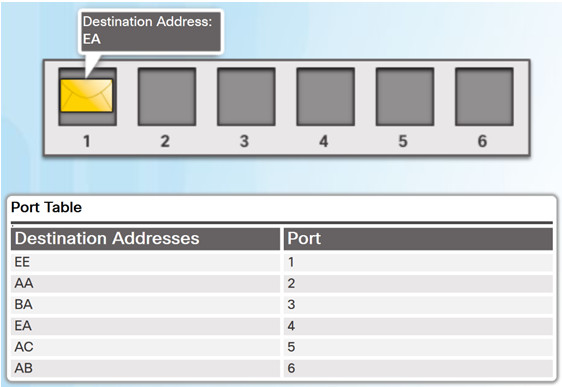
4.2.1.2 – Video Demonstration – MAC Address Tables on Connected Switches
The video explains how a switch builds its MAC address table by recording the MAC address of each device connected to each of its ports.

4.2.1.3 – Switch Forwarding Methods
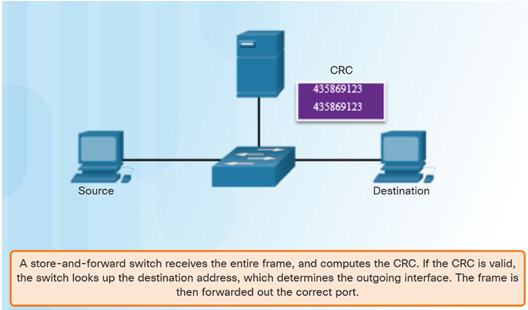
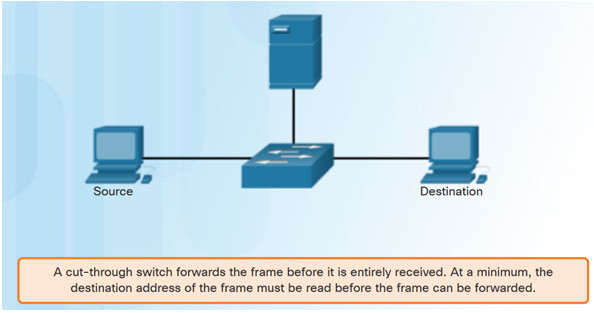
4.2.1.4 – Store-and-Forward Switching
Features of Store-and-Forward Switching:
- Error Checking– After receiving the entire frame, the switch compares the frame-check-sequence (FCS) value in the last field against its own FCS calculations. Only error-free frames are forwarded
- Automatic Buffering– ingress port buffering provides the flexibility to support any mix of Ethernet speeds.
Store-and-Forward is Cisco’s primary LAN switching method.
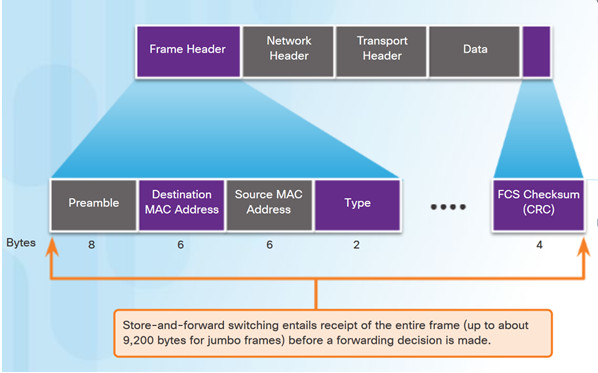
4.2.1.5 – Cut-Through Switching
Rapid Frame Forwarding – The switch can make a forwarding decision as soon as it has looked up the destination MAC address.
- Frames with errors are forwarded.
Fragment Free – modified form of cut-through switching. The switch waits for the collision window (64 bytes) to pass before forwarding the frame.
- Provides better error checking than cut-through, with practically no increase in latency.
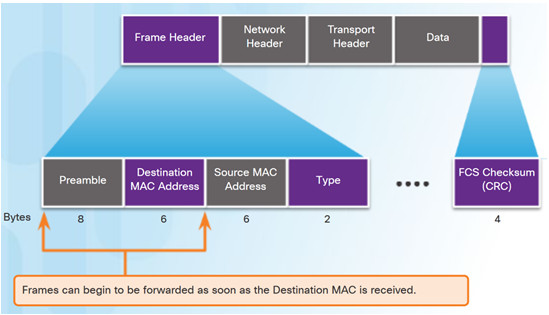
4.2.2 – Switching Domains
4.2.2.1 – Collision Domains
In hub-based Ethernet segments, network devices compete for the medium, therefore collisions will occur.
Ethernet switch ports operating in full duplex eliminate collisions.
Ethernet switch ports will autonegotiate full-duplex if connected to full-duplex device.
If connected to a half-duplex device then the switch port will operate in half duplex and be part of a collision domain.
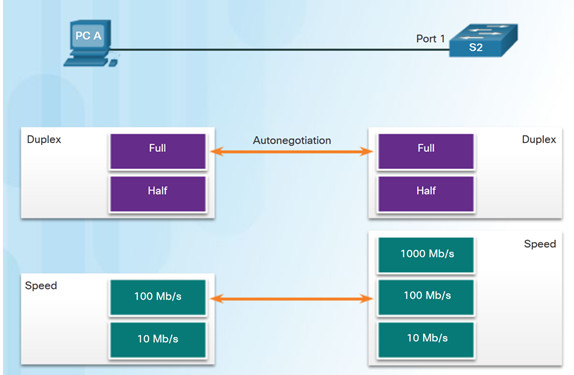
4.2.2.2 – Broadcast Domains
One switch or multiple interconnected switches form a single broadcast domain.
When a switch receives a broadcast frame, it forwards the frame out each of its ports, except the ingress port where the broadcast frame was received.
When two switches or more switches are connected together, the broadcast domain is increased because the broadcast is propagated from switch to switch.
Too many broadcasts can cause network congestion.
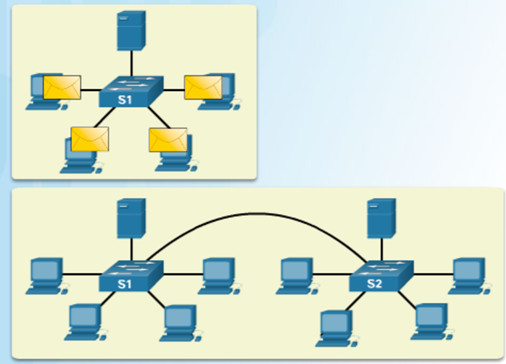
4.2.2.3 – Alleviating Network Congestion
The following characteristics of switches help alleviate congestion:
- Establishing full-duplex links, therefore eliminating collisions.
- High port density
- Large frame buffers
- Port speed
- Fast internal switching
- Low per-port cost
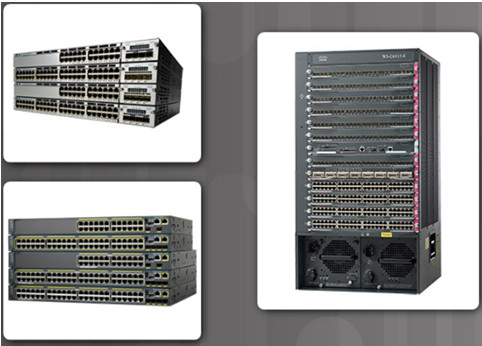
4.3 – Summary
4.3.1 – Conclusion
4.3.1.1 It’s Network Access Time Instructions
4.3.1.1 It’s Network Access Time Instructions
4.3.1.3 – Chapter 4: Switched Networks
Explain how switched networks support small to medium-sized businesses.
Explain how Layer 2 switches forward data in a small to medium-sized LAN.
New Terms and Commands
- network
- Call control
- Automated attendant
- PC softphone
- Cisco Borderless Network
- collapsed core layer model
- three layer hierarchical model
- access layer
- distribution layer
- core layer
- Port Density
- Frame Buffers
- Scalability
- rack units
- form factors
- Fixed configuration switches
- Modular configuration switches
- line cards
- Stackable configuration switches
- ingress
- egress
- MAC address table
- content addressable memory (CAM) table
- Ethernet bridges
- application-specific-integrated circuits (ASICs)
- store-and-forward switching
- cut-through switching
- cyclic redundancy check (CRC)
- egress port
- frame-check-sequence (FCS)
- buffer
- rapid frame forwarding
- fragment free
- Fragment free switching
- collision domains
- broadcast domains
- full duplex
- autonegotiate
- half duplex
- High port density
